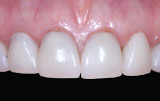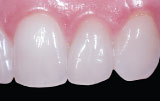Great Expectations — Perceptions in Smile Design
Is what you get what you want?
(Continued)
 |
 |
| Figure 5: The restorations (veneers) the patient presented with were dark in color and lifeless in appearance. | Figure 6: Replaced restorations showing a bright, vibrant smile uniform in color with new porcelain veneers. |
 |
 |
| Figure 7: An example of how the laboratory technician can make a crown look very natural with a transparent incisal edge (tip) on laboratory models. | Figure 8: The same crown from above placed into the patient's mouth creating a very natural appearance. |
 |
 |
| Figure 9: An example of teeth showing multiple colors from various materials used for the same patient. | Figure 10: An example of how slight color variations using the same materials can create a very attractive and natural appearance. |
 |
 |
| Figure 11: Old composite restorations and a single crown before replacement. | Figure 12: The same person illustrating how natural a smile can look once you and your dentist have successfully worked together to achieve the desired result. |
| Photos provided by Dr. Gerard Chiche | |
Communicating with the Dental Laboratory Technician
When planning a “shade prescription,” one must be aware that the most frequent shade variation of a front tooth is observed at the incisal third (biting edge). These are the technical details that need to be communicated in depth to the ceramist.
For the “Perfect-Minded” patient, the next most frequently observed category is when the shade distribution is nearly uniform, resulting in a monochromatic appearance (“mono” – one, “chroma” – color).
There are three typical scenarios that can be transmitted to the dental ceramist:
1. Lightly Monochromatic Shade DesignIt is very common to find patients who are so displeased by the dark appearance of their teeth [Figure 5] that they end up requesting a very monochromatic (uniformly colored or all white) look with high brightness [Figure 6]. The shade prescription given to the dental ceramist is uncomplicated due to a lack of incisal (biting edge) color effects.
2. Lightly Monochromatic Shade Design with Color EffectsThe typical natural incisal effects (biting edge) found on unworn incisors impart a very pleasing effect to the tooth shade overall. They include:
- Transparent incisal tip — an almost see-through effect of the tips of the teeth [Figures 7 and 8]
- Dentin streaks or mamelons (natural tooth characteristics especially on newly erupted or unworn teeth)
- Proximal translucency (an almost see through where adjacent teeth meet)
There are situations where several shades and various degrees of discolorations coexist in the same mouth; conversely, there are situations where different ceramic systems (types of porcelain) are present and do not perfectly match one another [Figure 9].
In such situations, the rule is to aim for maximum patient acceptance of the “restorations” [Figure 10]. This generally means that the central incisors are kept a slightly higher value than the other front teeth. If the value of the central incisors ends up a slightly lower value — due to some excessive translucency, for example — then it is very likely that the patient will reject the final result, even with the best designed proportions, display and length.
In Summary
Communication between you as the patient, your dentist and the laboratory technician are critical to the process of providing the best possible smile enhancements to meet your expectations. Research has shown that there are differences between individuals' perceptions and those of dental professionals regarding not only teeth but other factors affecting smiles and facial appearance. The dentist's role as health professional also includes educator and artist in this unique process, as the interpreter and creator of your vision of “beauty” [Figures 11 and 12].
The use of a special blueprint such as a “provisional restoration” is a useful tool to help envision potential changes before they are truly finalized. This can help ensure the most aesthetic and functional result for achieving your vision. Now the person in the mirror really can be the true you.

